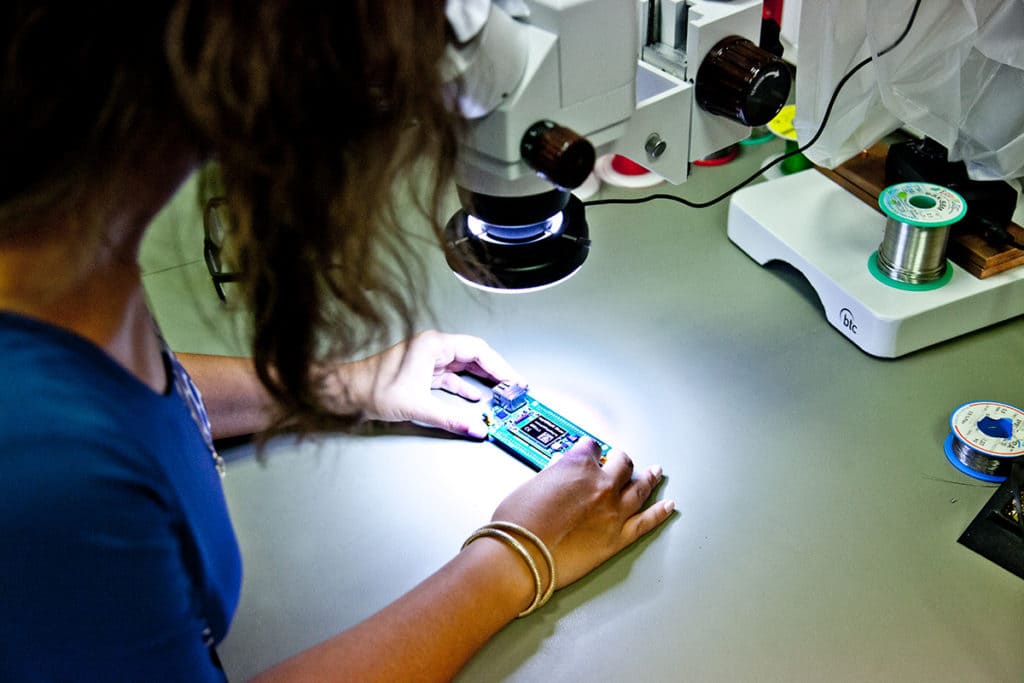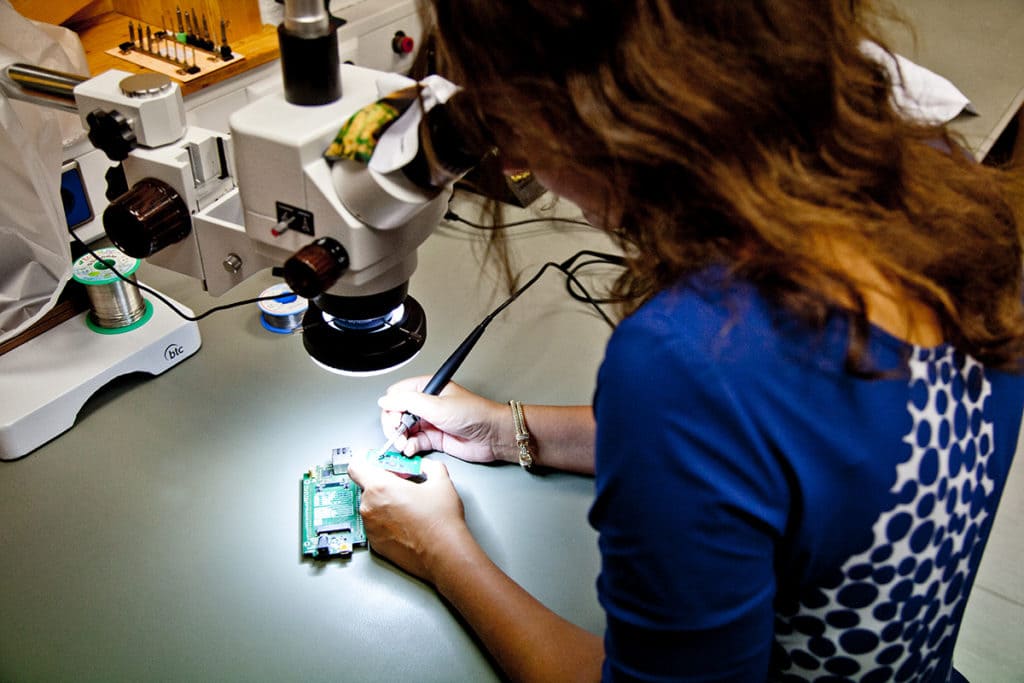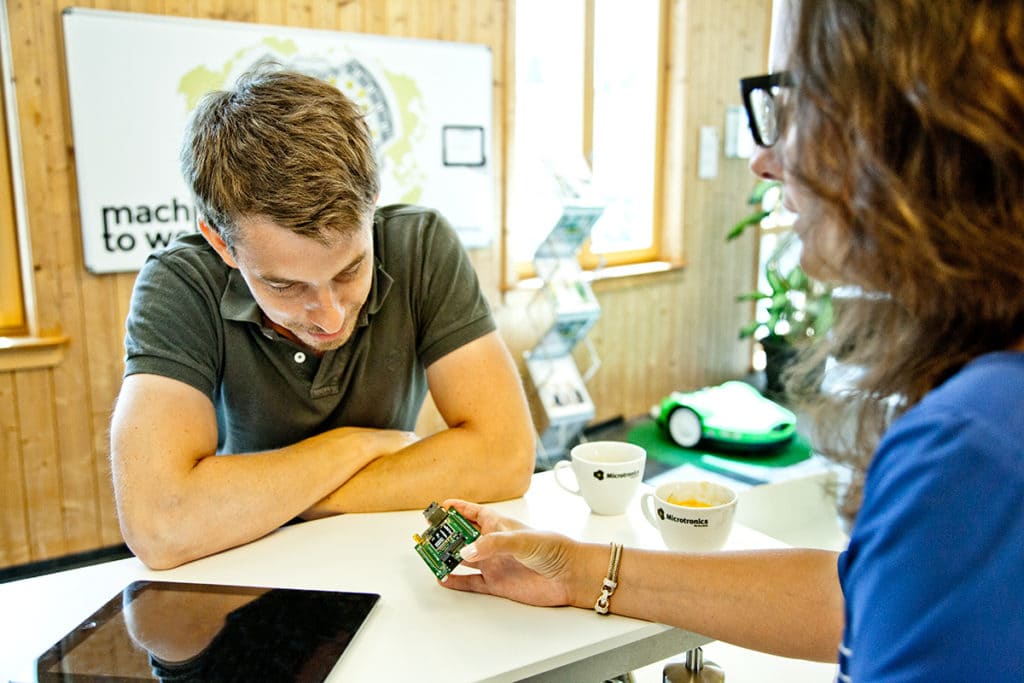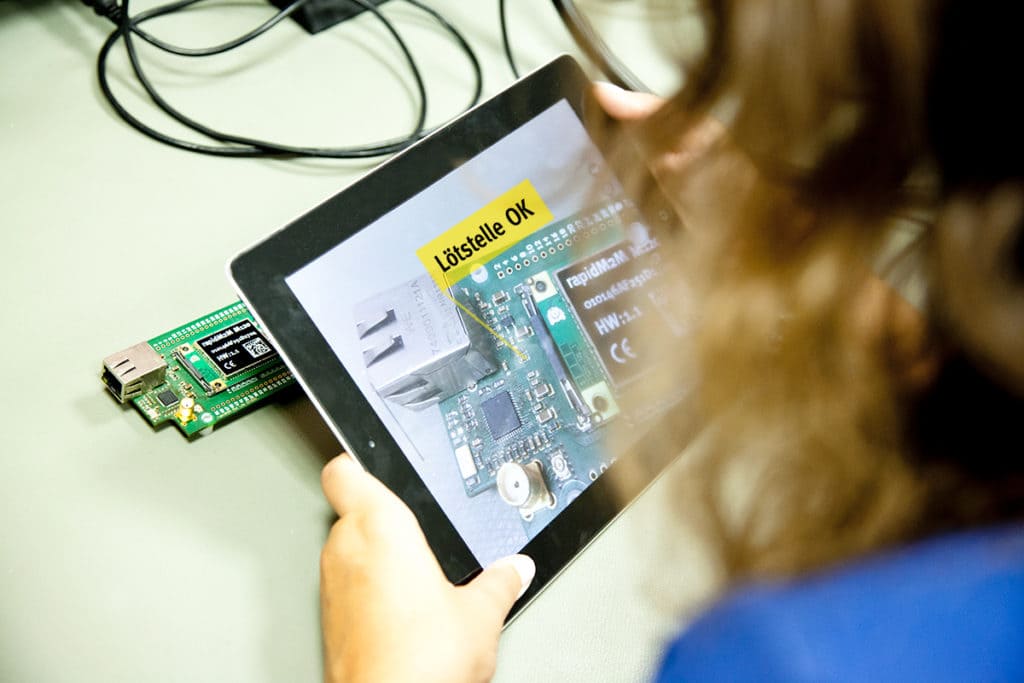Smart, connected products lead to a new infrastructure and generate valuable data. Therefore, a transformation or restructuring of traditional company functions is unavoidable. This starts with the product development and extend along the entire value chain.[1]
Depending on the strategic decisions taken, regarding the integration of smart, connected products, the necessary changes can be of a radical nature.[1]
One of the key decisions is whether the company develops the complete range of functions of the smart, connected products and the technology infrastructure independently or whether it should aim to cooperate with corresponding technology suppliers. A detailed description and 10 strategic decisions that have to be made in this context can be found in “Laying the foundation through strategic decisions”.
In this article, we look at the impact of smart, connected products on individual company functions. The following functional units are affected by this:
Product Development
Smart, connected products are complex systems. Functions are realised with the integrated software. The logic executed in the clouds adds even more functions. The composition of the development team is changing and the number of software engineers is increasingly exceeding the number of mechanical designers.[1]
Variability at low cost
Hardware functions are increasingly being replaced by software in smart, intelligent products. This enables a considerable higher variety of products variants at significantly lower costs compared to conventional products.
For example, display and control elements can be replaced by a digital user interface. This allows a simple and inexpensive modification of the control options.[1]
This approach is already used in passenger cars. Different languages or individual arrangements of the display and control elements can be realised at low cost.
Every component that can be replaced by software has the potential for an economic advantage and will therefore be replaced.[2]
Continuous product evolution
The ability to receive software updates remotely allows smart, connected products to evolve continuously long after they are deployed to customers. As a result, companies can bring products onto the market earlier if their development is not yet fully completed.[1]
This early customer contact is becoming increasingly important, since – due to network effects – it is usually essential to achieve high growth figures from the very beginning.[2]
New user interface and augmented reality
A digital user interface can be realised with a smartphone app. With this remote access the smart, connected product itself does not need any display or control element.
This type of user interface is characterized by lower implementation costs and less effort in case of modifications and allows the user a higher degree of mobility.
Augmented Reality is another important new discipline in product development and human-machine interface.[1]
Continuous quality management
Manufacturers are interested in testing their products under realistic conditions. This should ensure error-free operation over the entire planned period of use and minimise the number of warranty claims asserted.
Smart, connected products allow continuous monitoring of the performance of the product under actual conditions of use and enable detection of design or construction errors that have not come to light during the tests. Quality management reaches a completely new level.[1]
Improved customer service through networking
By integrating additional service and adding diagnostic functions to the software smart, connected products can be monitored remotely and potential failures can be detected in advance (predictive maintenance). Based on this networking of products new customers services can be offered.[1]
Basis for new business models
With additional data and remote access smart, connected products enable completely new business models. Products can be offered as services, for example. Further possibilities have already been discussed in detail in the article “Break the valid industry logic with smart, connected products”.
Interoperability with other systems
By means of “co-design” software and hardware are simultaneously developed and optimised across complete product families, whereby products from other manufactures can also be included. An API (Application Programming Interface) enables data exchange and thus interaction with products form other manufacturers.[1]
Production
The last steps of production (installation and configuration of the software) are shifting more and more towards the customer in case of smart, connected products. Additional tasks arise with regard to the service provided by the Cloud. The tasks of manufacturing therefore go beyond the mere manufacture of the products and also include the construction of the cloud.[1]
Smart Factories
The new capabilities of smart, connected machines make it possible to combine them into systems. This results in extensive changes to the production processes. Comprehensive networking of production machines should lead to fully automated cooperation and independent optimisation of the production process.[1]
Simplification of components
By substituting mechanical components with software functions, the physical complexity of the products is reduced. The reduction of physical components eliminates the associated production steps. Displays can be replaced by smartphone applications. However, as physical complexity decreases, the need for sensors and software increases and new components are required. This results in a new form of complexity.[1]
Redesigned assembly process
To support economies of scale and minimise storage costs, standard platforms are used in production which are only individualised as late as possible in the assembly process.
Smart, connected products make it possible to shift the time of individualization even further backwards. The installation or configuration of the software often takes places after the product has already left the factory. This can be done either by a service technician or by the customer himself.
For example, new applications can be added or the layout of the touchscreen keyboard can be adapted to the required language. Changes can therefore be made at the last minute even if the product has already been delivered.[1]
Production as continuous process
Smart, connected products are not working without the cloud. The production process therefore does not end with the manufacture of the actual product itself but comprises the operation and maintenance of the technological infrastructure and becomes a continuous process.[1]
Logistics
Smart, connected products enable continuous monitoring regardless of the current location of the product. In addition to the current position and the course of the transport route smart, connected products provide data on their current status (e.g. temperature or load due to acceleration forces) and their environment.[1]
Data on the current position and operational readiness as well as the prevailing weather and traffic conditions at the locations of the individual vehicles can, for example, optimise the coordination of a widely dispersed fleet by providing drivers with an appropriately adapted delivery route.
Marketing and Sales
Smart, connected products continuously generate information on their use. This shifts the focus of the customer relationship from (one-time) sale to maximizing the perceived value of the customer throughout the entire period of use. Countless news requirements arise. New opportunities are opening up at the same time.[1]
High-resolution market segmentation and customised offers
The information provided by smart, connected products provides more reliable insights into the actual use of the products and provides better information about which functions are particularly appreciated by customers than test series and customer surveys.[3]
Based on the analysis of these usage patterns, a more precise market segmentation can be performed and adapted offers, functions for specific segments and a pricing strategy based on the value of the product for the respective segment can be created.[1]
New customer relationships
With an increasing focus on the continuous creation of benefits for the customer, the importance of smart, connected products increases. Due to their ability to create a permanent connection between the company and its customers, these are increasingly perceived as valuable tools.[1]
New business models
The information provided on the use of smart, connected products enables new business models. These are explained in “Break the valid industry logic with smart, connected products”. The objectives are shifting towards securing the long-term success of customers and away from one-time sale.[1]
Focusing on systems
If products become part of systems, the range of value is also expanded. In addition to quality and functionality, the focus is on interoperability with related products. Companies must decide whether they want to offer individual products, entire product families or a superordinate platform that connects everything. Partnerships are often required to fill product gaps or enable connections to leading platforms.[1]
After-sales services
Smart, connected products allow the transition from a reactive service strategy to preventive, proactive and remote services, which can significantly improve quality efficiency.[1]
One-stop service
Thanks to the information provided by smart, connected products, the necessary spare parts and strategies for optimal troubleshooting can be identified in advance.[1]
Service via remote access
The remote access to smart, connected products, made possible by the connectivity, often allows repair or maintenance without the physical presence of a service technician. In most cases they have the same information about the condition of the product than if they were on site themselves. Often problems can be solved by a reboot and a user on site who acts with the help of the service technician. This leads to a significant reduction in service costs, reduction of downtimes and thus to a distinct increase in customer satisfaction.[1]
Preventive service
Companies can use predictive analytics to predict problems with smart, connected products and take preventive actions.[1]
Service with the help of augmented reality
The extensive data of smart, connected products in combination with step-by-step instructions enables augmented reality applications. This results in greater effectiveness and efficiency in maintenance and repair work.[1]
New services
The data, connectivity and analytics provided by smart, connected products can be used to create new service offerings and extend the traditional role of customer service.[1]
For example, a mining machinery manufacturer’s service team can provide the operator with tips on positioning the machine and optimizing the fuel consumption of the vehicles or point out overcapacities and bottlenecks based on the analysis of data from all vehicles and machines in a mine.
Security
While responsibility for securing IT structures (servers, networks and computers) used to lie exclusively with the IT department, this task now extends to all functional units due to the introduction of smart, connected products.
Smart, connected products usually placed in exposed locations and difficult to protect from physical access, are a potential target for cyber-attacks. This risk is exacerbated by the usually limited resources that make the use of modern security technology even more difficult.
The risks associated with hacks taking control of smart, connected products such as medical devices, generators or even cars and airplanes are disproportionately more serious than those arising from compromising a business email server.
The consideration of security concerns and the reduction of potential points of attack already in the course of product development are of decisive importance.
Techniques such as multi-level authentication, scheduled sessions and the determination of the type and time of data transfer by the user contribute to risk minimization.
The creation of data policies and their transmission to the company’s customers is an increasingly important task for legal, marketing, sales and other departments. In addition to customer concerns about data protection, these guidelines must also meet the increasingly stringent legal requirements and transparently explain what information is collected and how it is used by the company itself and any third parties.[1]
Human Resources
The mix of software companies and traditional manufacturing companies, which are manufacturers of smart, connected products, requires a number of new skills along the value chain as well as an adaptation of working methods and a change in corporate culture.[1]
New expertise
Whereas up to new mechanical engineers were mainly needed in the area of development, there is now an increasing number of software engineers.
The tasks of sales and marketing staff are shifting from selling traditional products to selling services.
Instead of carrying out repairs, service technicians are now entrusted with optimizing the availability of the systems and products.
In addition, it is necessary for manufacturing companies to recruit experts from areas not previously required – such as system integration, application technology and the development of user interfaces. Top derive suitable measures based on the data provided by smart, connected products specialists are also required who are able to develop and implement corresponding automated analysis procedures.[1]
New corporate culture
The development and manufacture of smart, connected products require a significantly higher degree of coordination between the individual functional units and departments of the company than that of traditional products.[1]
The different working styles of the employees have to be taken into account. For example, the “clock rate” of software development is usually significantly higher than that of hardware development.[1][4]
References list
- ↑ Porter, M. E., & Heppelmann, J. E. (2015, Oktober). How Smart, Connected
Products Are Transforming Companies. Harvard Business Review, S. 96–
114.
- ↑ Fleisch, E., Weinberger, M., & Wortmann, F. (2014a). Geschäftsmodelle im
Internet der Dinge. HMD Praxis der Wirtschaftsinformatik, 51(6), 812–826.
https://link.springer.com/article/10.1365%2Fs40702-014-0083-3
- ↑ Mayer, P. (2010, März). Economic aspects of SmartProducts. Whitepaper.
Instute of Technology Mangement, University of St. Gallen.
Series: Moving into a new business era with smart, connected products
Part 1: Introduction
Part 2: The importance of business model innovation
Part 3: Laying the foundation through strategic decisions
Part 4: Breaking the valid industry logic
Part 5: 5 value stages of an IoT application
Part 6: Transforming the value chain
Part 7: The value generation of things in the Internet of Things
Part 8: Fundamental design of smart, connected products
Part 9: Requirements for the technological infrastructure in the Internet of Things
Part10: Creating added value by advancing to smart products







